
Home - Search - Browse - Alphabetic Index: 0- 1- 2- 3- 4- 5- 6- 7- 8- 9
A- B- C- D- E- F- G- H- I- J- K- L- M- N- O- P- Q- R- S- T- U- V- W- X- Y- Z
Apollo LM Shelter
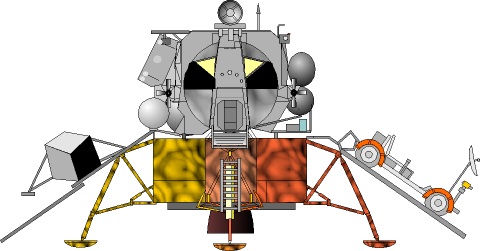
LM Shelter
Credit: © Mark Wade
AKA: LM Shelter. Status: Cancelled 1968. Payload: 2,300 kg (5,000 lb). Thrust: 44.04 kN (9,901 lbf). Gross mass: 14,700 kg (32,400 lb). Unfuelled mass: 6,700 kg (14,700 lb). Specific impulse: 311 s. Height: 6.37 m (20.89 ft).
Work was planned to begin in 1966, with 1-2 missions per year beginning in 1970 after accomplishment of the manned lunar landing goal. In the event, only the Lunar Rover vehicle, used in the later Apollo missions, ever saw actual use.
In a scenario requiring two Saturn V launches, the LM shelter would be landed on one launch, with a manned Apollo CSM accompanying it into lunar orbit but conducting lunar orbit surveying operations only. The CSM and its crew would then return to earth. A second Saturn V launch would deliver a CSM and LM Taxi combination to lunar orbit. The crew would take the LM taxi to the surface, landing near the shelter.
In order to house the astronauts during their 14-day stay a two-man STEP expandable shelter was an alternate to the LM Shelter. The STEP could be delivered by an LM descent stage together with a slightly higher discretionary payload than the LM shelter could carry. Either shelter would be delivered first by a logistics flight where the crew merely orbited in the CSM until the automated shelter-carrying LM had landed, and then returned to Earth, thus being able to use the Apollo CSM unchanged. The logistics flight was followed by the personnel transport. Because of the interval between first and second landing, the shelter-carrying LM had to be given a 90-day quiescent capability. The second flight would land the crew using the LM Taxi while the 30-day CSM waited in lunar orbit. After landing, the crew shut down the LM Taxi and activated the shelter system. Two weeks later, the LM Taxi was reactivated and the crew returned to the CSM and back to Earth.
By modifying the third stage of the Saturn V (S-IVB) for operation in lunar space, and by providing a 40-day quiescent capability for an unmanned CSM in lunar orbit, all three astronauts could be landed on the Moon for a 30-day stay time.
Crew Size: 2. Habitable Volume: 6.65 m3. Spacecraft delta v: 2,400 m/s (7,800 ft/sec).
Family: Lunar Habitats, Moon. Country: USA. Spacecraft: AES Lunar Base. Launch Vehicles: Saturn V. Propellants: N2O4/Aerozine-50. Agency: Grumman. Bibliography: 200, 201, 202, 203, 204, 26.
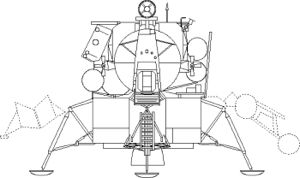 | LM Shelter Credit: © Mark Wade |
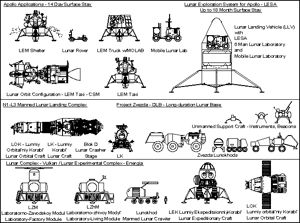 | Lunar Exploration Lunar Exploration Plans Credit: © Mark Wade |
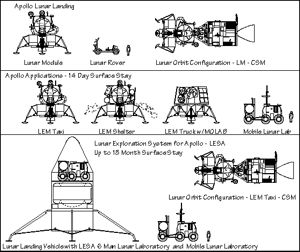 | Post-Apollo lunar Comparison of American post-Apollo lunar spacecraft. Credit: © Mark Wade |
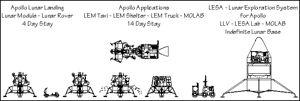 | Post-Apollo lunar Comparison of American post-Apollo lunar spacecraft. Credit: © Mark Wade |
1963 December 26 - . Launch Vehicle: Saturn V.
- Extension of Apollo systems to permit more extensive exploration of the lunar surface. - .
Nation: USA.
Related Persons: Shea,
von Braun.
Spacecraft: Apollo LM Shelter,
Apollo LM Taxi.
MSFC Director Wernher von Braun described to Apollo Spacecraft Program Manager Joseph F. Shea a possible extension of Apollo systems to permit more extensive exploration of the lunar surface. Huntsville's concept, called the Integrated Lunar Exploration System, involved a dual Saturn V mission (with rendezvous in lunar orbit) to deliver an integrated lunar taxi/shelter spacecraft to the Moon's surface. Additional Details: here....
1965 August - .
- Grumman final report on a study of LEM utilization for AES Earth-orbit missions. - .
Nation: USA.
Spacecraft: Apollo LM Lab,
Apollo LM Shelter,
Apollo LM Taxi,
Apollo LM Truck.
Grumman submitted to NASA its final report on a study of AES for Earth-orbit missions (conducted under the firm's contract for a LEM utilization study). The five-volume report comprised general engineering studies, mission and configuration descriptions for different groups of experiments (both NASA's and those for the Air Force's Manned Orbiting- Laboratory), and a cost and schedule analysis. Additional Details: here....
1966 July 11 - .
- NASA leaders make several significant program decisions affecting AAP and post-Apollo development planning. - .
Nation: USA.
Spacecraft: Apollo ATM,
Apollo LM Shelter,
Apollo LM Truck,
Apollo LRV,
Skylab.
NASA leaders make several significant program decisions affecting AAP and post-Apollo development planning. Meeting at Headquarters, Deputy Administrator Robert C. Seamans, Jr., Associate Administrator for Manned Space Flight George E. Mueller, and Associate Administrator for Space Science and Applications Homer E. Newell made several significant program decisions affecting AAP and post-Apollo development planning in general: MSFC would be the lead Center for developing the ATM and would be responsible for all astronomy experiments. MSFC would be the lead Center for 'lunar engineering'-i.e., design and development of lunar exploration vehicles (including surface modules, supply trucks, and roving vehicles). MSC would have responsibility for Earth resources and lunar scientific experiments.
1966 December 1 - .
- Modified lunar modules for a lunar exploration program - .
Nation: USA.
Spacecraft: Apollo LM Shelter,
Apollo LM Taxi,
Apollo LM Truck,
Apollo X.
John H. Disher released the report by a study group at Headquarters on various modified lunar modules suitable for a lunar exploration program as part of AAP. These modified craft took the form of a LM taxi, ferry and logistics craft, a LM shelter, and an 'augmented' LM. Disher authorized MSC to extend its engineering studies contract with Grumman to further define such modified LM configurations. He also asked MSFC to try to increase the Saturn V's translunar injection capability to 46 720 kg. These actions, he explained, afforded an opportunity to pursue any of several alternatives once future landing levels were known.
Back to top of page
Home - Search - Browse - Alphabetic Index: 0- 1- 2- 3- 4- 5- 6- 7- 8- 9
A- B- C- D- E- F- G- H- I- J- K- L- M- N- O- P- Q- R- S- T- U- V- W- X- Y- Z
© 1997-2019 Mark Wade - Contact
© / Conditions for Use